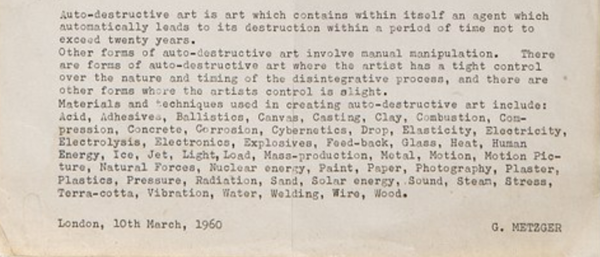I suggest this to reject the fetish of the Original Work, against which translation is always positioned.
To do so, I’m adapting this term from Gustav Metzger’s 1960 “Manifesto Auto-Destructive Art,” which states that “[a]uto-destructive art is art which contains within itself an agent which automatically leads to its destruction within a period of time not to exceed twenty years.” Compare this to Nathanaël’s claim in Hatred of Translation that “[e]mbedded in the translative act is not only a subdued destructive force, but an act of concealment, of its own archive, of resistance, why not, to itself.”

Translation is auto-destructive because retranslation exists. In the essay “Mother Courage’s Cucumbers: Text, System and Refraction in a Theory of Literature,” André Lefevere writes that “[b]oth the natural language and the politics of the receiving system keep changing; the spectrum through which refractions are made changes in the course of time.” Hence the automatic renewal of the need for retranslation.
“When the disintegrative process is complete the work is to be removed from the site and scrapped,” writes Metzger. But what gets scrapped is also the stability of the original object. If it’s all scraps, then translation shouldn’t be frightening. Metzger wants to “destroy art galleries. Capitalist institutions.” Translation breaks the frame of the gallery. It shows us the seams where the Grecian urn in the museum has been pieced back together.
Nathanaël writes, “the translator’s pretence to fluency is corrected when faced with the evidence of exclusion. The multiplication of versions decorticates the so-called original to the point of burning out the incumbent text—like the radioactive blast that photographs the city while annihilating it.”
According to Metzger:
“[a]uto-destructive art is an attack on capitalist values.”
In its unbounded chain of versions, translation rejects the gold standard of the cult of originality. André Lefevere points out that “[o]riginality can only exist if texts are consistently isolated from the tradition and the environment in which (against which) they were produced.” Or as Antoine Berman puts it in The Experience of the Foreign,
“[f]ar from being only the mere ‘derivation’ of an original supposed to be absolute, as the Law still defines it, the translation is a priori present in any original: Any work, as far as one can go back, is already to several degrees a fabric of translations or a creation that has something to do with the translating operation.”
Perhaps William Basinski’s Disintegration Loops are ideal models of translation. As the source loop decays through time, new tones and relations emerge that were buried in the texture of the original. A fetishist of originality would stop listening after one iteration of the loop. But the work assumes its iconic form over sixty-three minutes of reiteration and retranslation. Maybe this layering, this impasto of infinite versions, is the real “thickness” of translation, its twin processes of auto-destruction and auto-creation.
Zack Anderson holds an MFA from the University of Notre Dame. His book reviews appear in American Microreviews & Interviews, Harvard Review, and Kenyon Review. His poems have recently been published in Fairy Tale Review, The Equalizer, White Stag, and others. He currently lives in Athens, Georgia where he is a PhD student at the University of Georgia. @ZackAanderson